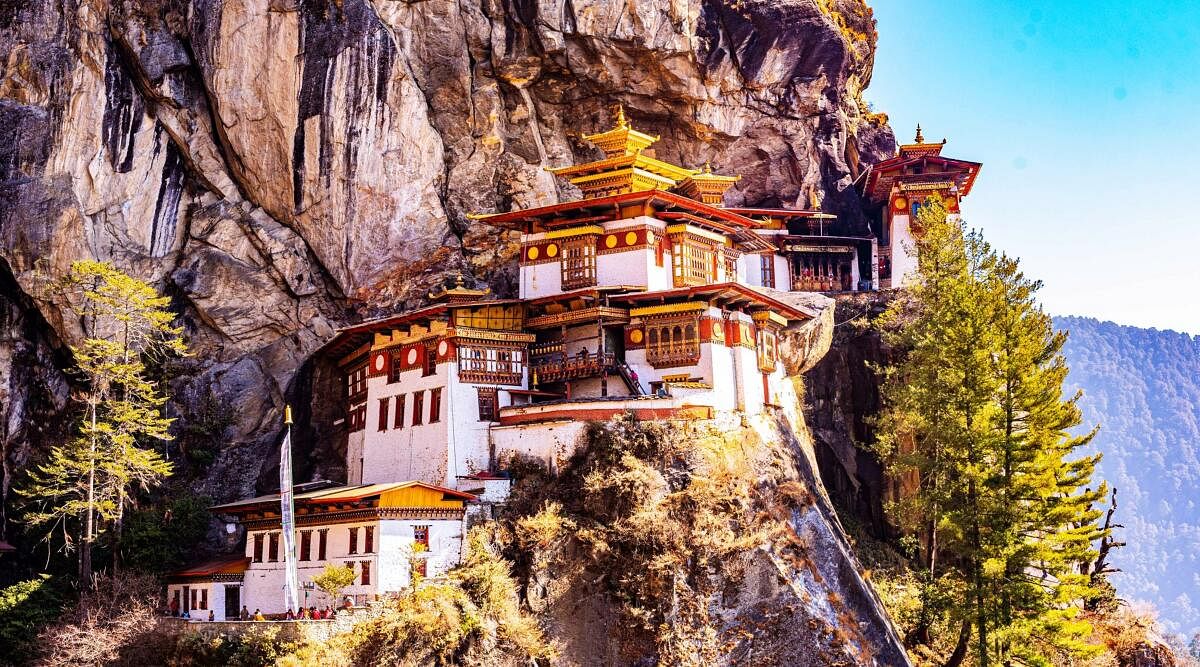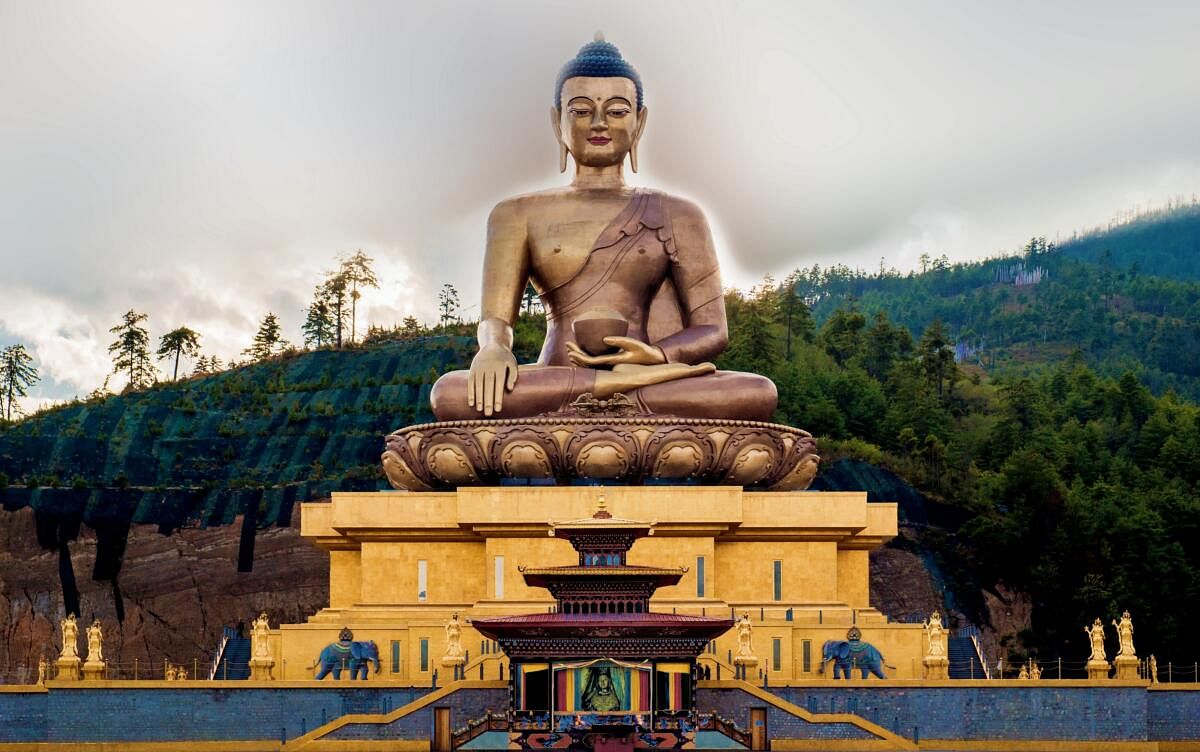

The world had been longing for the aural delights of Bhutan, the land of the thunder dragon, for two and a half long years, until it finally opened its doors to tourists again in September 2022. Indian travellers only need to part with 1,200 Ngultrum/day (Rs 1,200) SDF to take a dive into a spiritual pool of bliss and soak up the Bhutanese luxury. To experience the best of Bhutan’s culture — journey to the Tiger’s Nest, explore the textile and incense factories, be awe-inspired by the Dochula view, and hike the Trans Bhutan trail. While it may seem steep, it’ll all be worth it in the end.
Take the first step into Bhutanese history with a visit to the renowned Paro Taktsang Monastery — the iconic Tiger’s Nest. As the first light of morning brushes the valley, behold the breathtaking sight of robed monks ascending the cliffside to this ancient site. The sun’s rays glinted off the gilded domes and golden idols of the ancient white buildings, ushering in a new day of possibilities at this oldest site of Bhutan. Led by the resident scholar-monk, the 45-year-old Lam Tshering Dorji, I watched in awe as monks rotated the prayer wheel in the main courtyard, beckoning me to the wonders of this sacred place.
Staggering beneath the rocky face is the “Hall of a Thousand Buddhas”, a work of art that stands as a reminder of Bhutan’s past. This is where the legend of Guru Padmasambhava and the tigress that brought him to this very spot on her back, comes to life. With eight caves to explore, including four that can be easily navigated, Tiger’s Nest is the perfect adventure for thrill-seekers and spiritual seekers alike. To get to Paro Taktsang, you can either take the scenic route and trek through the paths — it’ll take three hours, but the view will be worth it, or cut your journey in half on a horseback or a mule for just $10. Next, whisk away to the world of Bhutanese Poe by embarking on an odyssey of the ancient hand-crafted incense sticks in Thimphu. Ap Nado, the 79-year-old owner of Nado Poizokhang has been crafting these masterpieces since the 60s. His incense formula has been a closely-guarded family secret ever since he and his daughter, Lamdon, stumbled upon it in a Buddhist monastery in India. Nado told me how each incense is produced with utmost care and precision, following ancient Buddhist scriptures, and made with organically grown flowers, bark, woods, leaves, fruits, and Bhutanese roots gathered by the highest of high, yak herders and families in the Himalayas.
These blends aren’t your typical creations, some use a 700-year-old recipe and they come in the form of Bamboo A, White Morning, and Red Evening. Some even contain 108 naturally-derived ingredients, a number of great importance in Buddhism. These fragrant delights come for a bargain of Ngultrum 65 ($1) to Ngultrum 1800 ($22). Another place that will blow you away with its incredible selection of fabrics in Thimpu, is the Thridung Nima Namza Tshongkhang textile factory. This factory, owned and operated by the 55-year-old weaving and textile expert Aum Ugyen Euden, offers a variety of Bhutanese fabrics like Kishuthara, Mathra, Hor and Sethra, made from imported silks, raw silks and cotton from India. Prices range from a mere 3000 Ngultrum (or $36) to a whopping 0.2 Million Ngultrum (or $2413). Aum Ugyen Euden showed me just how special and vibrant Bhutanese textiles are — something you won’t find anywhere else in the world.
Step above the incense and textile factories in Bhutan, and be enchanted by the majestic allure of the Himalayan mountain range. Here, Dochu La (la meaning pass) is sure to leave an indelible mark in your memory. This historic landmark, built by Ashi Dorji Wangmo Wangchuck, the eldest queen mother of Bhutan, is a popular attraction for travellers. The Druk Wangyel Chortens at Dochula, numbering 108 in total, stand as a tribute to the valiant Bhutanese soldiers who laid down their lives defending their homeland in the 2003 battle against Indian rebels. Sangay Dorji, my 36-year-old guide, elucidated how Druk Wangyal Lhakhang, a monastery dedicated to the revered Druk Wangyel symbolises the stability and progress that His Majesty brought to Bhutan. Before setting off on your journey away from Bhutan, take a step back in time and explore the untouched parts of this mystical country with the revived 16th-century Trans-Bhutan Trail, which had been dormant for over 60 years, until now. It was once the primary pilgrimage route and connector of fortresses (Dzongs) for Buddhist Trail runners, or Garps, who pushed themselves to traverse the terrain swiftly, with scarce food and rest. Taking the Trans-Bhutan Trail will offer visitors a unique, sustainable, net carbon-zero journey. If you’re looking for a unique travel experience that won’t have a negative environmental impact, Bhutan’s commitment to sustainable tourism is an ideal destination.
Insider tips: When you arrive at Paro Airport, exchange your foreign currency for Ngultrum and make sure to have your international credit cards handy. Don’t forget to download goBoB, the digital wallet app of the Bank of Bhutan, and get a local SIM card too. This way, you can make sure your journey will be convenient and unforgettable.